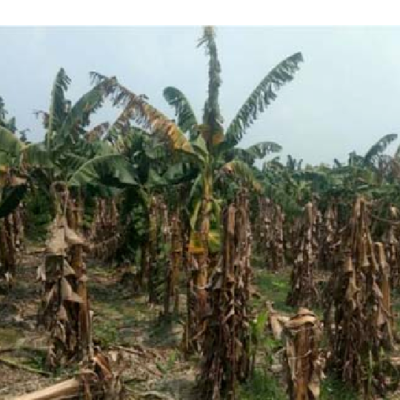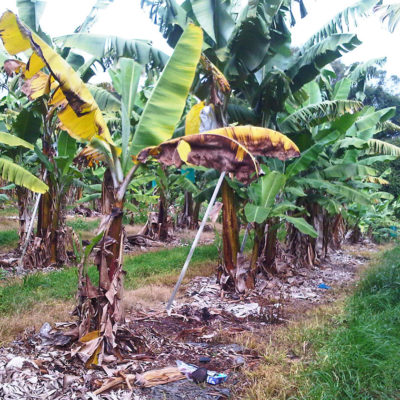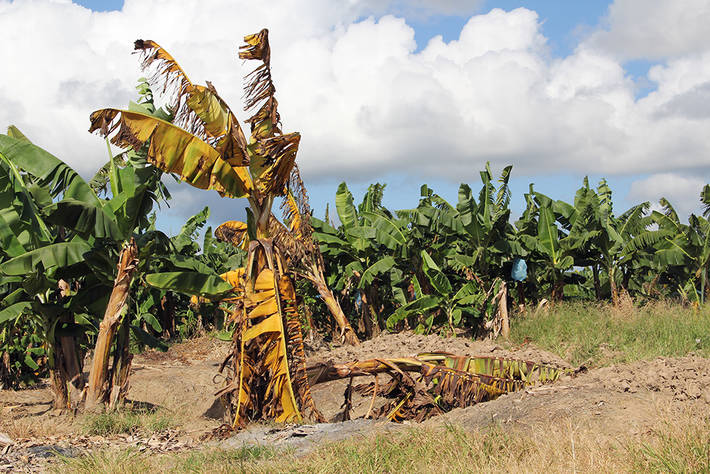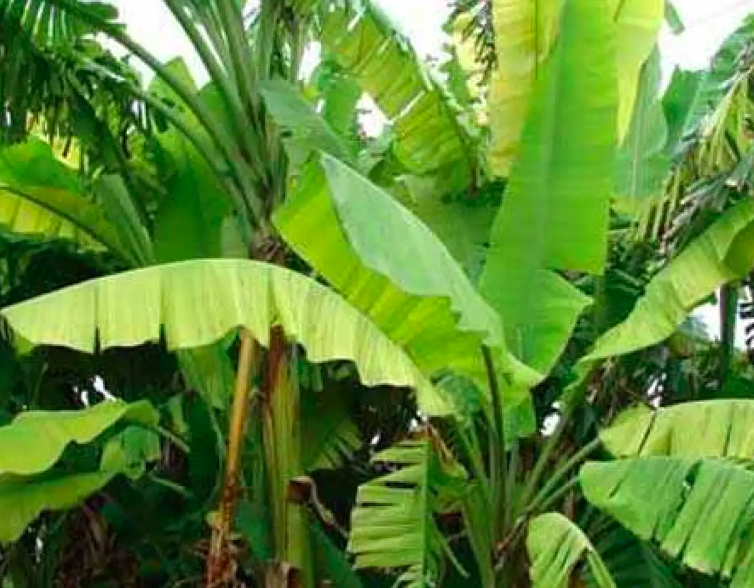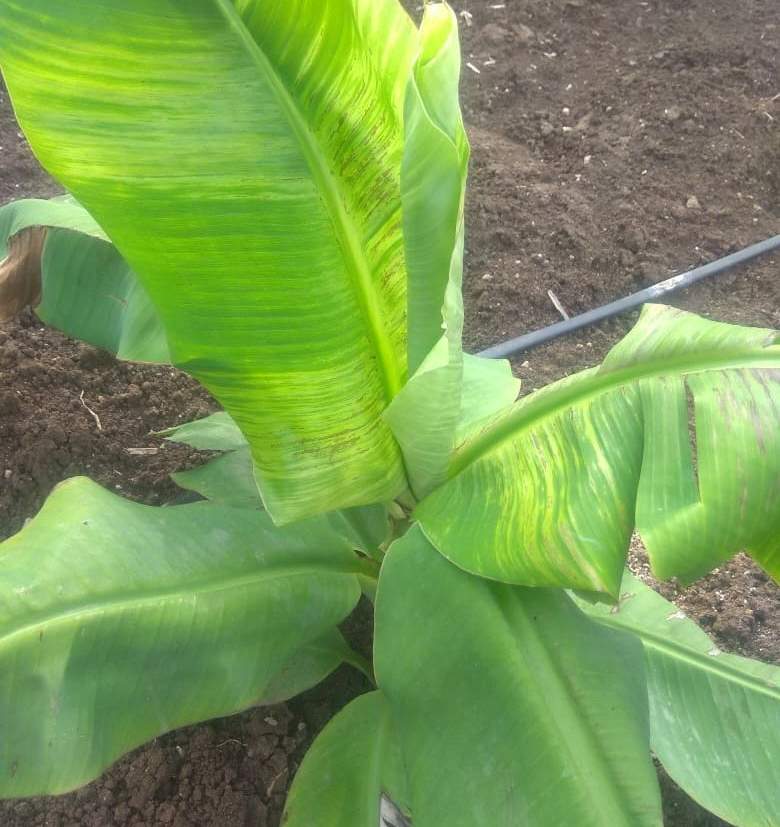Nature of Damage:
- Externally, the first obvious signs of disease in most varieties are wilting and a light yellow coloring of the lower leaves, most prominent around the margins. They eventually turn a bright yellow color with dead leaf margins.
- In the advanced stages of disease, affected plants may have a spiky appearance due to prominent upright apical leaves in contrast to the skirt of dead lower leaves.
- Internally, symptoms first become obvious in the xylem (water conducting) vessels of the roots and the rhizome. These turn a reddish-brown to maroon color as the fungus grows through the tissues.
- When a cross-section is cut, the discoloration appears in a circular pattern around the center of the rhizome where the infection concentrates due to the arrangement of the vessels. As symptoms progress into the pseudo-stem, continuous lines of discoloration are evident when the plant is cut longitudinally.
Symptom:
- Fusarium wilt is lethal disease.
- The symptoms are most apparent on at least 5 months old plants although 2-3 months old plant are also killed under highly favourable conditions. The earliest signs of the disease are faint yellow streaks in the petioles of oldest lower most leaf. Two types of symptoms follow this stage.
- In the yellowing type there is progressive yellowing of the old leaves and eventual collapse at the petiole.
- In the non yellowing type, the leaf collapses at the petiole without leaf chlorosis. Often all the leaves but the youngest collapses and the heart alone remain upright. The stem often shows more or less conspicuous longitudinal splitting of the outer leaf shealth from its outer covering. About 4-6 weeks after appearance of streaks on the petiole only the dead trunk of the pseudostem remains.
Disease cycle:
- The pathogen is a soil-borne surviving in soil mainly as chlamydospores formed by the hyphal and conidial cells.
- Infection is always through injure
Mode of Spread
- Disease spreads by infected rhizomes or suckers. Since infected suckers may not show symptoms, the pathogen can be unwittingly moved to non infected area when such materials are used.
- Over short distances, the pathogen moves within root systems of interconnected mats, in soil, running water, and infested tool and machinery.
Reason for severity:
- In the absence of a living banana host, it survives in previously colonized host tissue in soil.
- Root injury due intercultural or nematodes.
- Poor drainage.
- Lack of crop rotation.
Management:
- Sanitation by immediate removal of diseased plants with surrounding soil from the field.
- Cleaning of implements used in after planting the infested field before using it in other non infested field to prevent the spread of inoculums to other areas. Care during cultivation to avoid root injury and control of nematodes.
- Application of powder formulation of bioagents such as Trichoderma spp., Pseudomonas fluorescens and Bacillus subtilis @ 15 gms for 4 times once at time of planting in the planting pits and remaining doses at 3rd 5 th and 7th months after planting around the plants.
- Pairing (removal of roots and outer skin of corms) and dipping the suckers for 30 minutes in Solution containing carbendazim (2g/litre) and 0.05% monocrotophos (4 ml/lit.) prior to planting followed by drenching at bimonthly intervals starting from 5 months after planting or injection of corm with 3 ml of 2% carbendazim solution (20 g/lit) or embedding 50 mg of carbendazim capsule in corm
Chemical Control:
- Application of 2 % of Carbendazim as injection of Carbendazim 50 ml capsule application.
- Soil drenching of Carbendazim 0.2 % solution alternated with Propiconozole 0.1% around the pseudo stem at bimonthly intervals starting from five months after planting
- Application of urea + sugarcane trash (250g/pit) followed by lime (1Kg/pit) and neem cake (1- 2Kg/pit)
- Application of neem cake @ 250 Kg/ha was most effective in controlling Fusarium wilt.
Biological control:
- Application Pseudomonas fluorescens, a bactericide can also be applied along with farmyard manure and neem cake.
- About 60 mg of Pseudomonas (in a capsule) can be applied in a 10 cm deep hole made in the corm.
- Application of bio control agents like Trichoderma viride @ 25 g for 4 times once at the time of planting in the planting pit and remaining doses at third, fifth and seventh month after planting.
- Application of T.harzianum Th-10, as dried banana leaf formulation @ 10g/plats in basal + top dressing on 2,4,and 6 months after planting.
- Dipping the planting materials in spore suspension of P.fluorescens at 10g per plant at 3,5 and 7 months after planting.
Mechanical Control:
- Machinery and equipment should be treated with a sanitary solution such as Farmcleanse
- Footwear, which may have contacted banana plants or soil around banana plants elsewhere, should not be worn on the farm. — No agricultural vehicles, tools (including shovels, knives and ladders) or equipment should be removed from, or brought on to, the farm without prior approval from management.
- Provide mechanical barriers in and around the infected plants.
